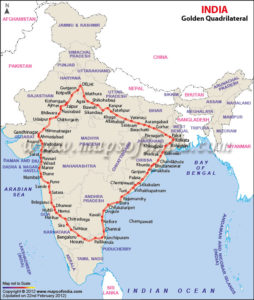
The Golden Quadrilateral is a highway network connecting many of the major industrial, agricultural and cultural centres of India. A quadrilateral of sorts is formed by connecting Chennai, Kolkata, Delhi and Mumbai, and hence its name. Other metropolises also connected by the network are Ahmedabad, Bengaluru, Bhubaneswar, Jaipur, Kanpur, Pune, Surat, Vijayawada, Ajmer, and Vizag .
The largest highway project in India and the fifth longest in the world (5846 km), started by NDA Government led by Prime Minister Atal Bihari Vajpayee it is the first phase of the National Highways Development Project(NHDP), and consists of building 5,846 km (3,633 mi) four/six lane express highways at a cost of ₹600 billion(US$9.4 billion). The project was launched in 2001 by Atal Bihari Vajpayee under the NDA government, and was completed in 2012.
The four sections of the Golden Quadrilateral:
Section I: This covers National Highway 2 (NH2) from Delhi to Kolkata. Total stretch is 1454 km. States covered are Delhi, Haryana, Uttar Pradesh, Bihar, Jharkhand and West Bengal. Major cities include Delhi, Mathura, Faridabad, Agra, Allahabad, Firozabad, Kanpur and Varanasi.
Section II: This covers NH6 from Kolkata to Chennai, NH60 (Kharagpur to Balasore) and NH5 (Balasore to Chennai). Total stretch is 1684km. States include West Bengal, Andhra Pradesh, Orissa and Tamil Nadu.
Section III: Total stretch is 1,290km. It covers parts of NH4 (Mumbai to Bangalore), NH7 (Bangalore to Krishnagiri, Tamil Nadu) and NH46 (Krishnagiri to nearby Chennai). States include Maharashtra, Karnataka, Andhra Pradesh and Tamil Nadu.
Section IV: Covering parts of NH 8 (Delhi to Kishangarh), NH 79A (Ajmer bypass), NH 79 (Nasirabad to Chittaurgarh) and NH 76 (Chittaurgarh to Udaipur), the stretch is 1,419km. States include Maharashtra, Gujarat, Rajasthan, Haryana and New Delhi. Major cities connected are Delhi, Ajmer, Udaipur, Gurgaon, Jaipur, Gandhinagar, Ahmedabad, Vadodara, Surat and Mumbai.

Cost
India’s government had initially estimated that the Golden Quadrilateral project would cost ₹600 billion (US$9.4 billion) at 1999 prices. However, the highway has been built under-budget. As of August 2011, cost incurred by Indian government was about half of initial estimate, at ₹308.58 billion (US$4.8 billion). The eight contracts in progress, as of August 2011, were worth ₹16.34 billion (US$250 million).
Economic benefits
The projected economic benefits of the GOLDEN QUADRILATERAL project are –
- Establishing faster transport networks between major cities and ports.
- Providing an impetus to smoother movement of products and people within India.
- Enabling industrial and job development in smaller towns through access to markets.
- Providing opportunities for farmers, through better transportation of produce from the agricultural hinterland to major cities and ports for export, through lesser wastage and spoils.
- Driving economic growth directly, through construction as well as through indirect demand for cement, steel and other construction materials.
- Giving an impetus to Truck transport throughout India.
No. Segment Total Length Completed % Date
1 Delhi-Kolkata 1453km (903 mi) 100 31 Aug 2011
2 Chennai-Mumbai 1290km (800 mi) 100 31 Aug 2011
3 Kolkata-Chennai 1684km (1046 mi) 100 31 May 2013
4 Mumbai-Delhi 1419km (882 mi) 100 31 Aug 2011
Total 5846km (3633 mi) 100 31 May 2013
Length in each state
The completed Golden Quadrilateral passes through 13 states:
- Andhra Pradesh– 1,014 km (630 mi)
- Uttar Pradesh– 756 km (470 mi)
- Rajasthan– 725 km (450 mi)
- Karnataka– 623 km (387 mi)
- Maharashtra– 487 km (303 mi)
- Gujarat– 485 km (301 mi)
- Odisha– 440 km (270 mi)
- West Bengal– 406 km (252 mi)
- Tamil Nadu– 342 km (213 mi)
- Bihar– 204 km (127 mi)
- Jharkhand– 192 km (119 mi)
- Haryana– 152 km (94 mi)
- Delhi– 25 km (16 mi)
- Total – 5,846 km (3,633 mi)


